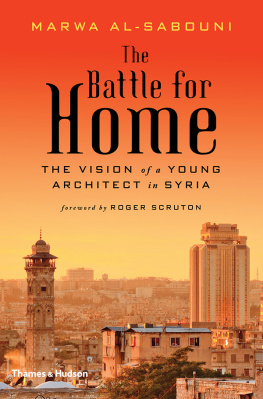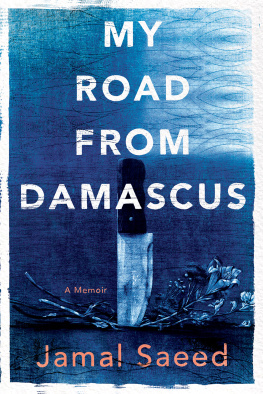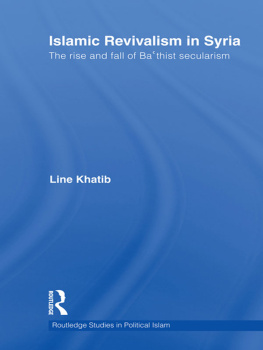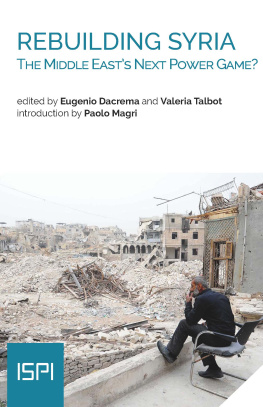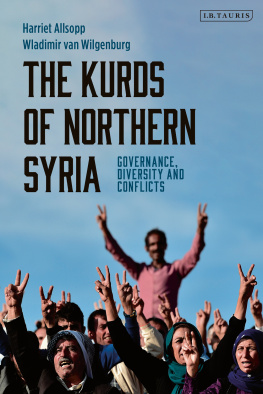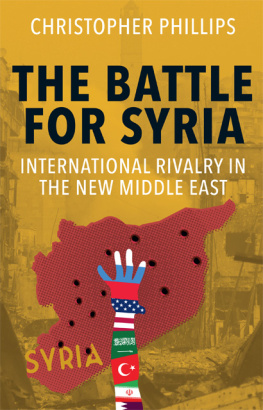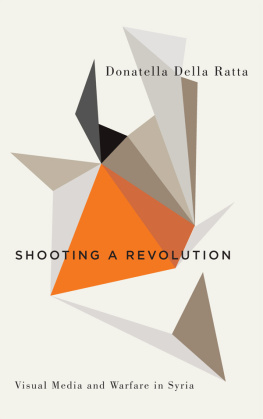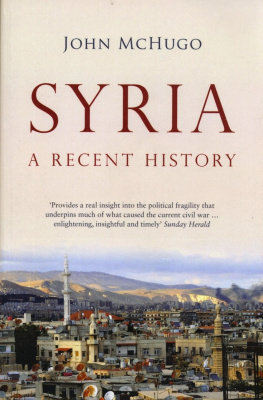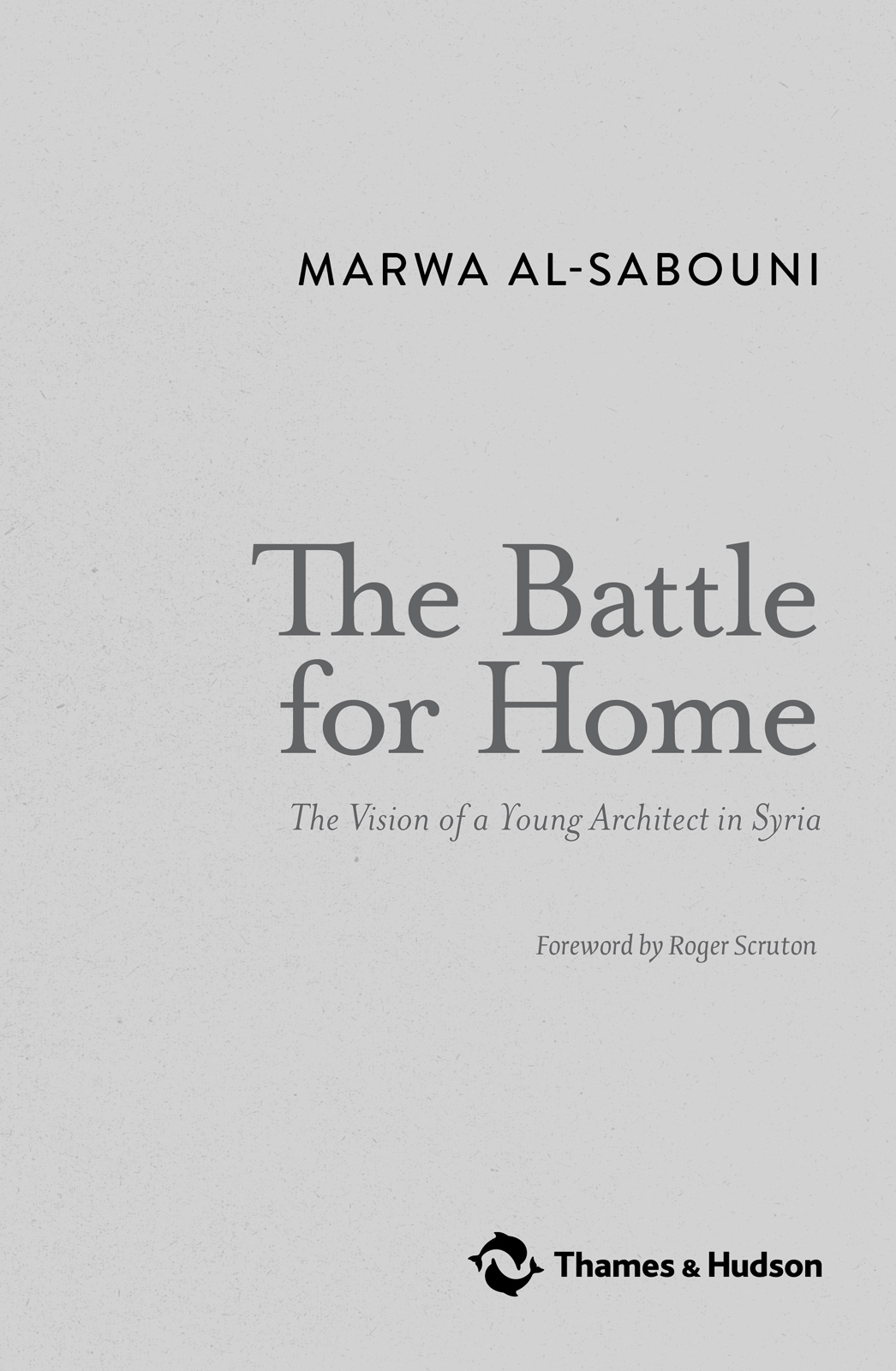
About the Authors
Marwa al-Sabouni has a PhD in Islamic architecture and runs a private architectural studio in Homs, Syria. She has published several articles in periodicals such as the RIBA Journal, Architectural Review, Wall Street International, CityCity Magazine and Architects + Artisans. She is also co-owner of the award-winning www.arch-news.net , the first and only online media site dedicated to architectural news in Arabic.
Roger Scruton is a writer and philosopher specializing in aesthetics, with a particular interest in the Levant and architecture.
Other titles of interest published by
Thames & Hudson include:
Open Source Architecture
Architecture in Wood
The Elements of Modern Architecture
Words and Buildings
See our websites
www.thamesandhudson.com
www.thamesandhudsonusa.com
Contents
In which the author looks at the circumstances that led to war, exploring through her personal experience as a young woman and student architect contradictions in the concept of freedom, as manifested in various aspects of life in Homs.
In which the author uses Homs as her model to focus on the interdependent relationship between society and architecture, and the repeated damage to both that created fertile ground for civil war.
In which the author explores the role of urbanism in creating and inflaming civil strife: comparing the relationship between trade, religion and settlement in Homs and Damascus, and the way this has played a role in uniting/dividing societies; and looking at the added impositions of colonialism and the challenges presented by other newcomers.
In which the author focuses on the newcomer settlement of Baba Amr, reviewing a history of prejudice, alienation and corruption, made manifest in the built environment and paving the way for conflict.
In which the author looks at pre-conflict housing in Syria and the role of architecture in breaking down a sense of identity; at different cases of homelessness and dispersal after the outbreak of war; and at the concept of accomplishment as a measure of national identity and a factor in shaping new settlements.
In which the author examines the roots of lost identity in ill-advised stereotyping, misconceptions, poor education and corrupt institutions, all manifested in architecture; and proposes a new way forward architecturally towards accomplishment, acceptance and ultimately healing.
It was no small surprise for me to receive, two years ago, an e-mail from Homs in Syria, asking me to explain something in my book The Aesthetics of Architecture. How could that book have reached Homs, of which I knew only because the tragedy of the Levant had occupied me over the last twenty years? And who was this person so eccentric as to devote time to issues of architectural aesthetics, when all around her the fabric of her ancient city was falling in ruins? I replied immediately, and very soon was in regular correspondence with one of the most remarkable people I have never met. Now she has written her own book, and it is the work of a profound thinker with a unique ability to address one of the most pressing questions confronting the people of the Middle East, which is the question of their built environment.
So far only two models have been proposed for a Middle Eastern city that is to be in communication with the modern world. One is Le Corbusiers plan for Algiers, which involves demolishing everything and trapping the traumatized populace in concrete blocks under motorways. The other is Dubai, a bombastic and profligate fun park of petrol-dollar materialism designed on computers in London for the global rich. The idea of a city in which prosperous and poor, old and young, Muslim and Christian, live peacefully side by side in streets that they share, beneath a skyline respectful of their religious aspirations the idea represented by cities such as Homs, Aleppo and Damascus in the great moments of their past has had no part to play in the plans of the futurist bureaucrats and modernist computer nerds. Yet, as Marwa al-Sabouni clearly shows, the plans imposed on cities like Homs by those charged with their public aspect have been major contributors to the conflicts that have now destroyed them.
The metropolis came into being in the Eastern Mediterranean, and has been the ancient solution to human difference the way in which diverse communities settle side by side and imprint their agreements on the earth. Marwa al-Sabouni argues that the Syrian people must rediscover the feeling for place and materials, for the street, the faade and the shared skyline, that created their cities, which have endured in continuous occupation since ancient times. She gives a moving account of traditional Islamic architecture and the way in which its principles have been misunderstood or bowdlerized into architectural clichs. And she boldly criticizes the corruption that has surrendered her city to both materialist vandalism and hate-filled revenge. In all this she eloquently describes a Syrian city as it now is, in the midst of a conflict that we in Europe have so imperfectly understood, and the costs of which we shall have to bear.
This book is the moving record of one persons effort to stay loyal to her homeland, at a time of great suffering and personal distress. It tells a painful and tragic story. But it is also the expression of a beautiful soul, who comes to us out of a confused and dreadful battle with a message of hope.
Malmesbury, September 2015
We in Syria have been in the news since 2011. The world has been watching us, and we have been watching ourselves, getting killed, tortured and uprooted. We have seen our buildings demolished, our cities destroyed and our archaeological treasures vandalized. These images have been on display so much that we rarely question why all this has happened. In politics and history, when narratives are assembled, parties tell their own sides of the story. It is only through architecture that we see the point of view that is no ones in particular and everyones in general. Buildings do not lie to us: they tell the truth without taking sides. Every little detail in an urban configuration is an honest register of a lived story.
In this book, I try to show that in the built environment we can find not only indicators of events that have already occurred, but also portends of what could or might still occur. In addition, I try to show how architecture in my country has played a vital role in creating, directing and heightening conflicts between warring factions, by facilitating poor choices and narrowing viable alternatives. I write about the shape of settlements and related economic systems, the moral code inspired by the architecture of a place, and the ways in which architectural choices can determine questions of identity and home. Relating to another reason why I wrote this book, it should be noted that even in countries that seem to be distanced from our own misfortune in Syria (especially the other countries touched by the so-called Arab Spring), notions of identity and home are just as much in jeopardy.
The world has watched with anguish as ISIS has vandalized or threatened treasured sites, including Palmyra in Syria and the Assyrian towns in Iraq. It has witnessed the tragic destruction of the Old Souks of Aleppo and Homs, along with countless ancient buildings and relics caught in the crossfire. These losses, despite their severity, are of course incomparable to the human losses the wasted and damaged lives of innocents, and the destruction of the social fabric but they constitute further reasons for me to write this book: to consider the paths that have led to this ordeal and to shed light on the role played by the built environment. I suggest that the failure to create architecture that can constitute a home for its users stems from a loss of identity, which in turn has causes that go deep into the psychology of our people. When we look at what is being built in the Middle East today and how it is being built, this loss of identity becomes glaringly apparent, as does the jarring disconnection between the rich heritage of the past and the empty modernism now being imported to form the present.
Next page
